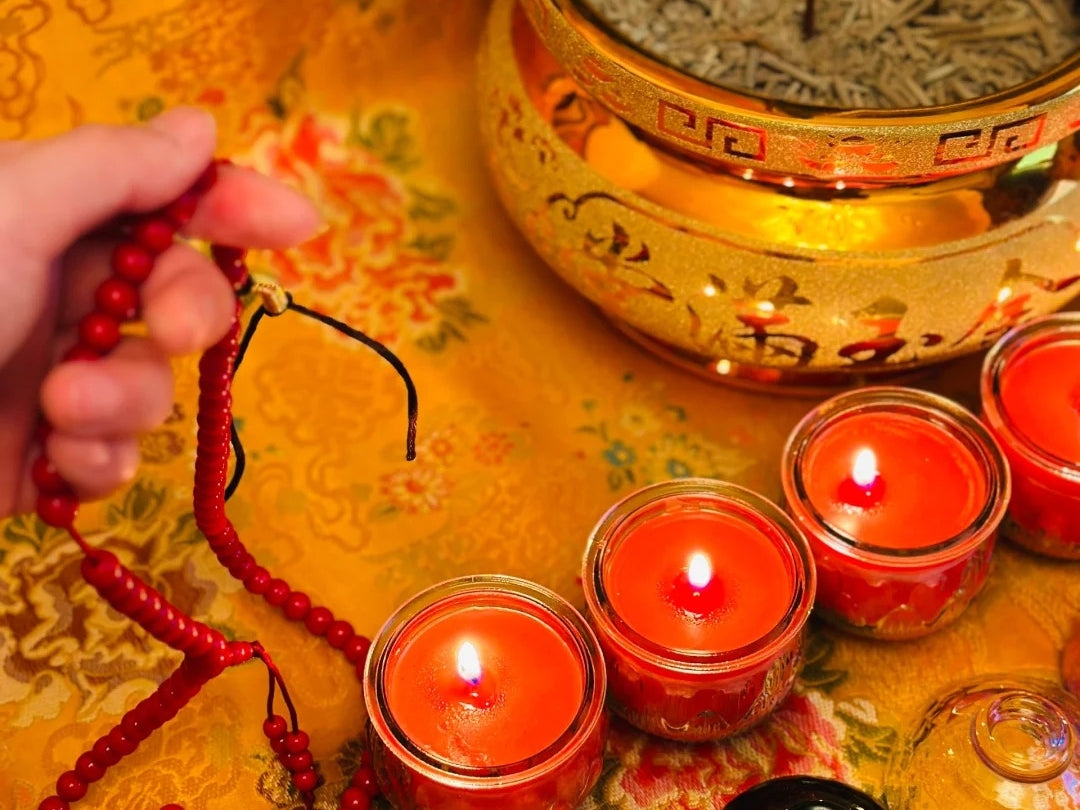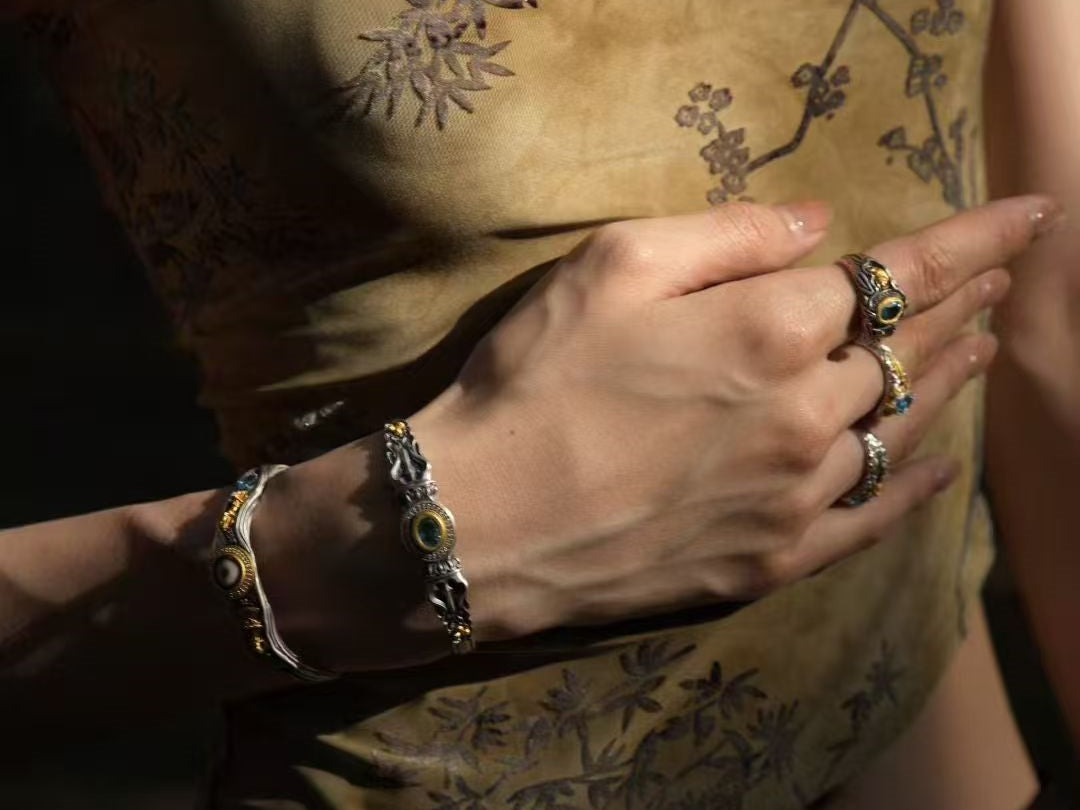Thangka painters have long mixed minerals and plant materials into paints whose depth and luminosity feel almost otherworldly. Today, artisans who translate Thangka palettes into enamel, painted gawu (amulet) boxes, and tiny pendants are carrying forward that visual language—but those same pigments are delicate, and preserving their color and meaning requires care. This guide explains the classic pigments used in Thangka painting, why they matter culturally, how jewelers adapt those colors, and straightforward conservation tips so you can protect hand-painted pieces.

Ancient palettes: what Thangka pigments were made from—and why that matters
Traditional Thangka color comes from ground minerals and carefully prepared organics rather than modern synthetic dyes. Common historical ingredients include azurite and lapis for deep blues, malachite for greens, cinnabar or vermilion for reds, orpiment and realgar for yellows and oranges, and calcium-based whites and earth pigments for tone and body. These materials were prized not only for hue and opacity but also for their ritual significance—mineral pigments were often considered sacred because of their natural origin and long durability when properly handled.

Cultural weight behind the color
In traditional practice, pigments are more than paint: they participate in the devotional act. The lapis-like blues or cinnabar reds that grace a Buddha’s robe connect the object to a material lineage—gems and minerals that were valued in spiritual contexts. Conservators and practitioners treat Thangkas with particular reverence for this reason, and careful, culturally informed approaches are used when treating sacred paintings.

How contemporary jewelers translate Thangka color into wearable art
When makers adapt Thangka palettes for small-format jewelry—enamel gawu panels, hand-painted mini-Thangkas mounted in pendants, or painted brass lockets—they face three technical challenges: scale (tiny surfaces need fine brushes and stabilized paint layers), colorfastness (exposed jewelry sees light, skin oils, and friction), and substrate compatibility (metal, glass, and modern primers behave differently than textile ground). To meet those challenges, responsible makers take one of three routes:
-
Traditional natural pigments on protected grounds: Some artists still grind minerals into binders and apply them under clear glass or within a sealed gawu window—this provides both authenticity and physical protection.
-
Enamel and vitreous techniques: Jewelers sometimes translate mineral blues and greens into vitreous enamel—fused glass layers that are hardier for daily wear while echoing the translucence of original pigments.
-
Stable modern pigments with traditional palette sensibility: Where long-term wear is expected, artists select light-fast modern paints that match historical hues, then protect them with lacquered or glass coverings.
All approaches aim to honor the original color language while adapting to the realities of wearable objects.
Basic conservation rules for hand-painted jewelry and gawu pieces
If you own a hand-painted pendant or a tiny Thangka mounted in a gawu, follow these practical, noninvasive steps to help preserve color and structure. Many of these suggestions mirror museum practice for larger Thangkas and painted objects.
-
Limit light exposure. Ultraviolet and bright visible light fade pigments irreversibly over time. Store painted pieces in a dark pouch or box when not worn and avoid leaving them on sun-lit surfaces. For display, prefer low, indirect lighting and rotate items rather than showing them constantly.
-
Control humidity and temperature. Rapid humidity swings cause ground layers and paint to expand and contract, flaking or lifting tiny paint particles. Aim for stable, moderate humidity (a helpful household target is roughly 40–55% relative humidity) and avoid storing painted pieces in bathrooms or damp basements.
-
Handle carefully—minimize touch. Skin oils and sweat can discolor mineral pigments or disturb delicate varnishes. When adjusting a pendant, touch metal parts rather than painted surfaces; consider wearing a cotton inner layer if a painted gawu box sits against skin.
-
Gentle cleaning only. Use a very soft, dry brush (a sable or clean camel-hair brush) to remove dust. Avoid water, chemical dips, or household polishes on painted surfaces—these can dissolve binders or strip patina. If metal needs cleaning, protect painted areas with a barrier or seek a conservator’s advice.
-
Protective glazing and seals. Where appropriate, choose pieces with a protective glass window or a stable varnish layer. If an item lacks protection, consult an experienced conservator before applying any coating yourself; inappropriate coatings can cause long-term damage.
Storage and travel: simple habits that extend life
-
Keep painted pendants in individual soft pouches and store them flat to avoid abrasion.
-
Use silica gel packets to moderate humidity inside storage boxes (replace periodically).
-
When traveling, carry painted pieces in a padded case away from toiletries and perfumes, and avoid stowing them in checked luggage where pressure and temperature vary widely.
Buying advice: what to ask the maker
If you’re shopping for Thangka-inspired jewelry or a hand-painted gawu pendant, polite questions help you assess conservation risk and authenticity:
-
Which pigments and binders did you use—natural mineral pigments, enamel, or modern paints?
-
Is the painted surface sealed or protected behind glass?
-
How should I clean and store this piece?
Sellers who know and share these details usually take craft and conservation seriously.
When to consult a conservator
If a painted pendant shows flaking paint, bubbling, or discoloration after wear, stop using it and seek professional advice. Conservators trained in Asian paintings or small-object conservation can stabilize fragile layers and recommend safe display or wear options.
Closing note: stewardship as devotion
Preserving Thangka pigments in contemporary jewelry is as much a cultural responsibility as it is a practical one. Caring for painted pendants and enamel gawu boxes preserves their visual beauty, honors the material lineage of Thangka practice, and respects the devotional intent behind the imagery. With a few simple habits—mindful handling, light management, and informed buying—you can enjoy these portable shrines for years while protecting the fragile colors that make them sing.





